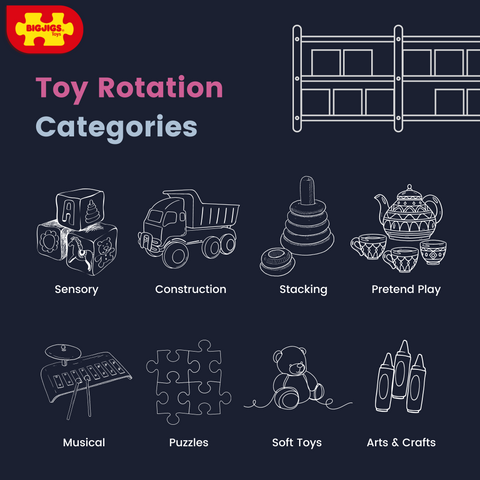
A Guide to Toy Rotation: What It Is and How to Implement It
Is your toddler losing interest in their toys? Consider a new approach with toy rotation. Inspired by Montessori parenting styles, toy rotation is an excellent method to combat toy boredom and encourage deeper, more meaningful play.
Toy Rotation for Toddlers: What? Why? When? How?
Why Consider Toy Rotation?
Research shows that having too many toys can overwhelm young minds, hindering their creativity, imagination, and concentration. Instead of enriching playtime, toy overload can actually lead to boredom and disinterest. In this case, less truly is more.
What is Toy Rotation?
Toy rotation is a straightforward and effective method inspired by Montessori parenting styles. It involves periodically swapping out toys to keep your toddler engaged and excited. This approach ensures children have access to a manageable number of toys, reducing clutter and enhancing the quality of play.
How Does Toy Rotation Work?
- Select a Few Toys: Arrange a handful of toys on a low shelf that your toddler can easily reach. Cube storage units work well for this purpose.
- Store the Rest: Keep the remaining toys in a cupboard or another storage space out of sight.
- Rotate Regularly: When you notice your toddler growing bored with the available toys, switch them out for a few from the stored collection. This refresh keeps their interest alive and maintains an element of novelty.
What are the benefits of rotating toys?
Toy rotation benefits for kids:
- Fosters independent thinking and choice-making
- Avoids overstimulation
- Enhances focus and concentration
- Improves quality of play
- Boosts creativity and imagination
- Reduces boredom
- Keeps things new and exciting!
Toy rotation benefits for parents:
- Cuts out clutter
- Clean-ups are easier and quicker
- Reduces frustration caused by mess
- Creates more space
- Save money by making old toys feel new again when you bring them out of storage!
What are some toy rotation categories?
The idea is to give your kids a choice of toys that offer different types of play. Your toy rotation categories could include sensory toys, construction toys, stacking toys, pretend play sets, musical or percussion instruments, puzzles, soft toys and arts & crafts.

Don’t stress about categorizing the toys too much. The key is to have a varied selection each time. Our award-winning Simply Scandi Range offers beautifully crafted wooden toys that will look gorgeous on your toy rotation shelf.
How Many Toys Should You Include in a Rotation?
Through experience, we’ve found that around 10 toys are ideal for toy rotation. This provides a good mix of playthings without overwhelming your child.
How Often Should You Rotate Toys?
There are no strict rules, but rotating toys every 1-2 weeks often works well. A good guideline is to observe your child's behavior. If they seem uninterested in their current selection, it’s time for a change. Rotating in new toys on a Friday can set you up for a more relaxed weekend as your child enjoys a fresh selection of 'new' toys. You don’t have to swap out every toy each time; just replace the ones that aren’t captivating your child's interest.
What Age is Toy Rotation For?
The ideal time to start toy rotation is less about age and more about your baby’s interest in playing. It works well once your tot can crawl and reach for their toys, and it becomes even more effective when they reach toddlerhood (from 12 months) and their engagement in play increases. However, toy rotation is beneficial at any age as it helps keep toys organized and provides variety without overwhelming your child.
Toy Rotation in 5 Easy Steps
-
Declutter: Sort through all your toys and donate those your child has outgrown.
-
Categorize: Use large storage boxes to sort toys into specific categories (e.g., sensory toys, soft toys, crafts). Store the toys you’re keeping in these labeled boxes.
-
Display: Select a couple of toys from each box and place them on your shelving. (TIP: Toddlers often find toys like puzzles and ring stackers more interesting when they’re left ‘unfinished’ and ready for them to play with.)
-
Hide: Store the remaining toys (inside their categorized boxes) in a cupboard away from your child’s view.
-
Rotate: Swap out toys your child isn’t interested in every 1-2 weeks, or whenever you feel the time is right.

Share Your Montessori Playroom Setup!
We’d love to see photos of your own toy rotation selections, so tag us on Instagram @bigjigstoysca and let us know how it’s going!

